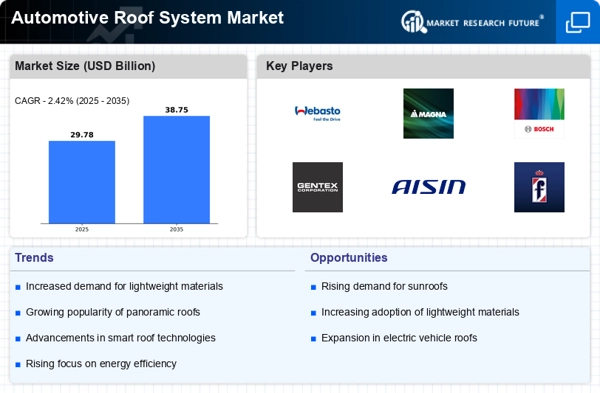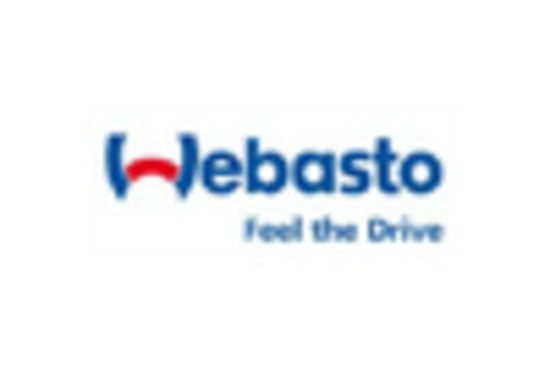Rising Demand for Electric Vehicles
The increasing adoption of electric vehicles (EVs) is a pivotal driver for the Automotive Roof System Market. As consumers become more environmentally conscious, the demand for EVs is projected to rise significantly. According to recent data, the EV market is expected to grow at a compound annual growth rate (CAGR) of over 20% in the coming years. This surge in EV production necessitates innovative roof systems that enhance aerodynamics and energy efficiency. Manufacturers are likely to focus on lightweight materials and advanced designs to cater to this trend, thereby influencing the overall dynamics of the Automotive Roof System Market. Furthermore, the integration of solar panels into roof systems may also gain traction, providing additional energy sources for EVs and further driving market growth.
Consumer Preference for Aesthetic Appeal
The growing consumer preference for aesthetic appeal in vehicles is a notable driver for the Automotive Roof System Market. Modern consumers increasingly seek vehicles that reflect their personal style and preferences, leading to a demand for customizable roof systems. This trend is particularly evident in the luxury vehicle segment, where unique roof designs and materials can significantly influence purchasing decisions. Market data suggests that the luxury car segment is expected to grow at a CAGR of approximately 5% over the next few years. Consequently, manufacturers are likely to focus on offering a variety of roof options, including different materials and designs, to cater to this demand. This shift towards personalization and aesthetic enhancement is expected to propel the Automotive Roof System Market forward.
Regulatory Standards and Safety Features
Regulatory standards and safety features are increasingly influencing the Automotive Roof System Market. Governments worldwide are implementing stringent safety regulations that require manufacturers to enhance the structural integrity and safety of vehicle roofs. This includes the need for roofs that can withstand rollover accidents and provide better protection for passengers. As a result, manufacturers are investing in advanced materials and engineering techniques to meet these regulations. The market for reinforced roof systems is anticipated to grow as safety becomes a paramount concern for consumers. Additionally, the integration of safety features such as rollover sensors and advanced airbag systems into roof designs is likely to become more common, further driving innovation within the Automotive Roof System Market.
Sustainability and Eco-Friendly Materials
Sustainability is emerging as a critical driver for the Automotive Roof System Market. With increasing awareness of environmental issues, manufacturers are under pressure to adopt eco-friendly materials and production processes. The use of recyclable materials in roof systems not only reduces the carbon footprint but also appeals to environmentally conscious consumers. Market Research Future indicates that the demand for sustainable automotive components is expected to rise, with a projected CAGR of around 8% in the coming years. This trend is prompting manufacturers to explore alternative materials such as bio-based composites and recycled plastics for roof systems. As sustainability becomes a key focus, the Automotive Roof System Market is likely to evolve, with companies prioritizing eco-friendly innovations to meet consumer expectations and regulatory requirements.
Technological Advancements in Roof Systems
Technological advancements play a crucial role in shaping the Automotive Roof System Market. Innovations such as panoramic sunroofs, retractable roofs, and smart glass technologies are becoming increasingly prevalent. These advancements not only enhance the aesthetic appeal of vehicles but also improve functionality and user experience. For instance, the incorporation of smart glass allows for dynamic tinting, which can adjust to sunlight exposure, thereby enhancing passenger comfort. The market for smart glass in automotive applications is projected to grow significantly, indicating a shift towards more sophisticated roof systems. As manufacturers invest in research and development to integrate these technologies, the Automotive Roof System Market is likely to witness substantial growth driven by consumer demand for enhanced features and functionalities.


















Leave a Comment